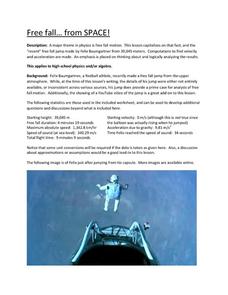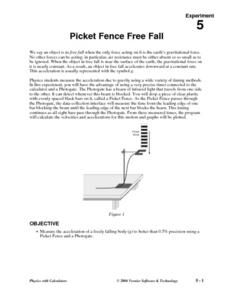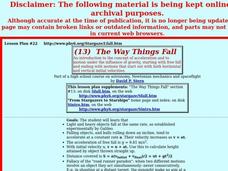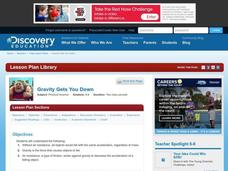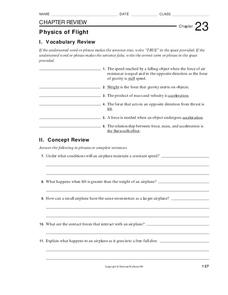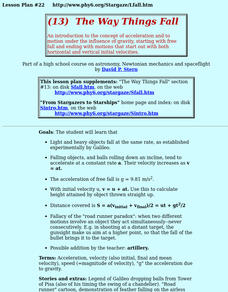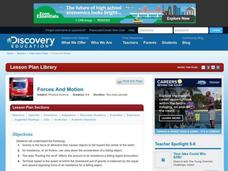Physics Classroom
Free Fall
Scholars must understand freefall before they learn how objects like airplanes fly. They apply knowledge of velocity and acceleration to predict speed and direction as part of a larger series on vectors and projectiles.
University of Wyoming
Free Fall…From SPACE!/Nanotechnology in the Classroom
Provide the details about Felix Baumgartner's sky jump from the far reaches of our atmosphere, 39,045 meters up! Then get your physics free fallers to evaluate the factors that played a role in his acceleration, the time to reach maximum...
Curated OER
Lesson 3: Acceleration and Force
A nine-page physics resource supports your instructional activity on acceleration. A step-by-step lesson plan walks you through the materials you need, the background information, steps for leading experimentation, and the explanation of...
Curated OER
Acceleration
Speed up the class's understanding of acceleration with a presentation! The resource includes a definition, example problems, acceleration due to gravity, and a graphical representation of acceleration.
Curated OER
Free Fall
Students investigate the law of gravity and how an object can accelerate while going through a free fall. They examine the influence of air resistance and how it can influence the momentum of an object. The instructional activity...
Curated OER
Unit VI: Worksheet 1 - Constant Force/Gravitational Force
Seven problems regarding gravitational pull are presented in this physics drill. Pupils solve for displacement, time, speed, and acceleration. Critical thinking and problem solving skills are both required to complete the assignment.
Curated OER
Gravitational Potential Energy
In this energy worksheet, students use the gravitational potential energy equation to solve for mass, height, or free-fall acceleration. This worksheet has 10 problems to solve.
Curated OER
Picket Fence Free Fall
Students measure acceleration using a Picket Fence and a Photogate. In this physics lesson, students drop an object and measure the acceleration of the object free falling. They log their data using the TI.
Curated OER
The Way Things Fall
High schoolers explore concept of acceleration and motion under the influence of gravity, starting with free fall and ending with motions that start out with both horizontal and vertical initial velocities.
Curated OER
Free Fall Graphing Exercise
Twelfth graders practice their graphing skills in an exercise about acceleration due to gravity. Lesson opens with a demonstration of acceleration due to gravity and a brief discussion. Students complete a worksheet and go over answers...
Curated OER
Gravity Gets You Down
Students investigate the force of gravity and how it effects different objects that are put into acceleration when applied the experiment of free falling. They drop different objects that have a variety of masses and some that cause air...
Curated OER
Gravitational Acceleration
Students investigate the interdependence of mass and gravitational acceleration using computer simulation. In this physics lesson plan, students derive the formula for acceleration due to gravity. They calculate air resistance on falling...
Curated OER
Force Problems
Who knew F=MA could determine the force of a free-falling elevator? Give your class this set of thirteen word problems for practice determining force, mass, and acceleration of everyday objects. One question introduces an object in...
Curated OER
Gravity Gets You Down
Students design an experiment to investigate how objects with different masses fall. In this physics lesson, students predict how these objects will fall in a vacuum tube. They write a report explaining experimental results and conclusion.
Curated OER
Weightlessness
Students predict the behavior of coffee in a cup while it is dropped during a demonstration. They relate their observations to the weightless conditions that astronauts experience in space and discuss the concept of free-fall.
Curated OER
Gravity Study Guide
In this gravity worksheet, students define terms such as free fall, terminal velocity, and inertia. Then students compare the different types of forces that act upon objects. This worksheet has 9 short answer and 4 fill in the blank...
Curated OER
Gravity: It's GREEEAAATTT!
Students calculate effects of gravitational force on planets, discuss the effects of weightlessness on the human body and describe and demonstrate how objects in a state of free fall are accelerated by gravity at an equal rate.
Curated OER
Physics of Flight
In this flight worksheet, students will review the physics behind flight including lift, acceleration, and thrust. Students will also understand the Bernoulli effect. This worksheet has 6 true or false, 6 short answer, and 8 matching...
Curated OER
The Way Things Fall
Learners see that light and heavy objects fall at the same rate, as established experimentally by Galileo. They see that falling objects, and balls rolling down an incline, tend to accelerate at a constant rate a. Their velocity...
Curated OER
Weightlessness
Young scholars use a coffee cup to demonstrate weightlessness. After a lecture/demo, students read an article on free-fall. They perform a simple experiment which helps them explain the concept of weightlessness.
Curated OER
Forces and Motion
Students build parachutes for chicken eggs. In this physics instructional activity, students describe the forces acting on a falling object. They predict which of the three parachute models they made has the best chance of keeping the...
Curated OER
Velocity and Acceleration
Twelfth graders look at local speed limits and traffic controls and see if they are reasonable. They plot the displacement and time to represent velocity, develop a plan for improving the current system, and organize experimental...
Curated OER
Physics: Bounce - Projectile Motion and Collisions
Students conduct and observe experiments in Newtonian mechanics, kinematics, and projectile motion. They analyze the motion of a ball rolling off a table, falling, and then bouncing. Students answer a series of questions analyzing the...
Curated OER
Force Counterforce
Students hypothesize what forces affect the motion of a falling body. In this physical science lesson, students create diagrams and illustrations to support their hypothesis. They perform the experiment and record observations.



